How to Grow Peas for Beginners
How to Grow Peas for Beginners so you can fill your garden with another amazing vegetable that your family will love to snack on. Add peas to your garden lineup so you can have a summer snack while you are out tending to your other plants.
Be sure to check out our entire Gardening 101 library that is full of How to Grow resources that will help you plant, tend, harvest, and eat the summer foods you love.
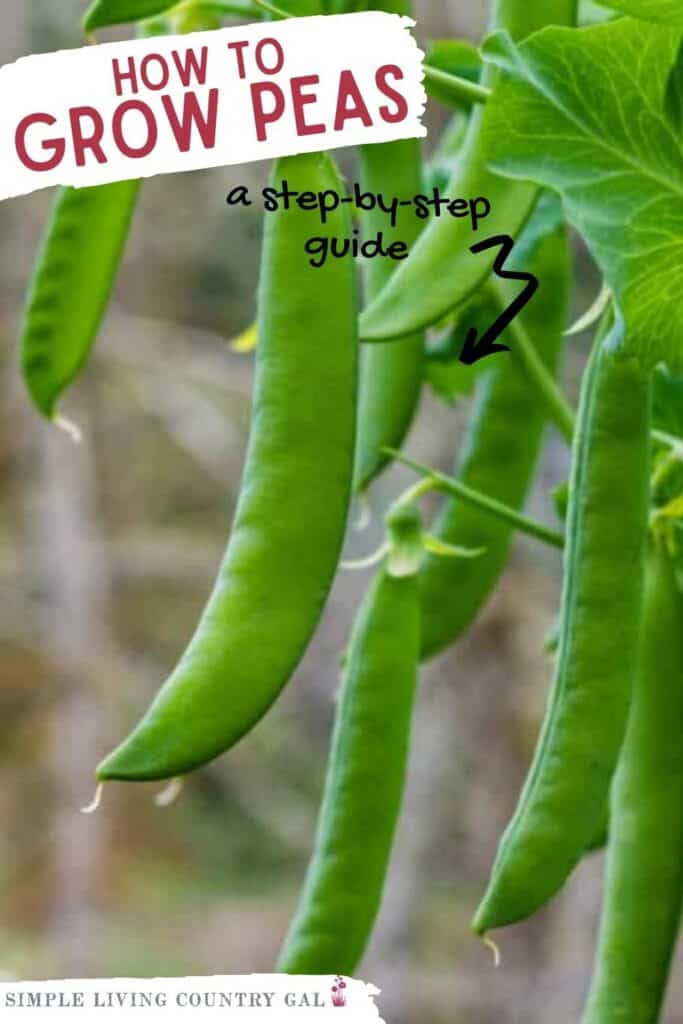
There is a memory I have with my kids. Going out to the garden to do a bit of weeding, and after only a few minutes, I look up to see them munching down on peas, relaxing in the morning sunshine. It is a memory I cherish and one I hope to share with my grand-boys someday soon.
Every year I plant 4-5 sweet pea plants so we have a snack ready while we are out working. Not all the produce in our gardens needs to be harvested and preserved. It is okay to add a few plants of foods you love to enjoy in the moment.
Gardening is more about homesteading; it is also about family time and getting outdoors in nature, creating memories that we can look back on.
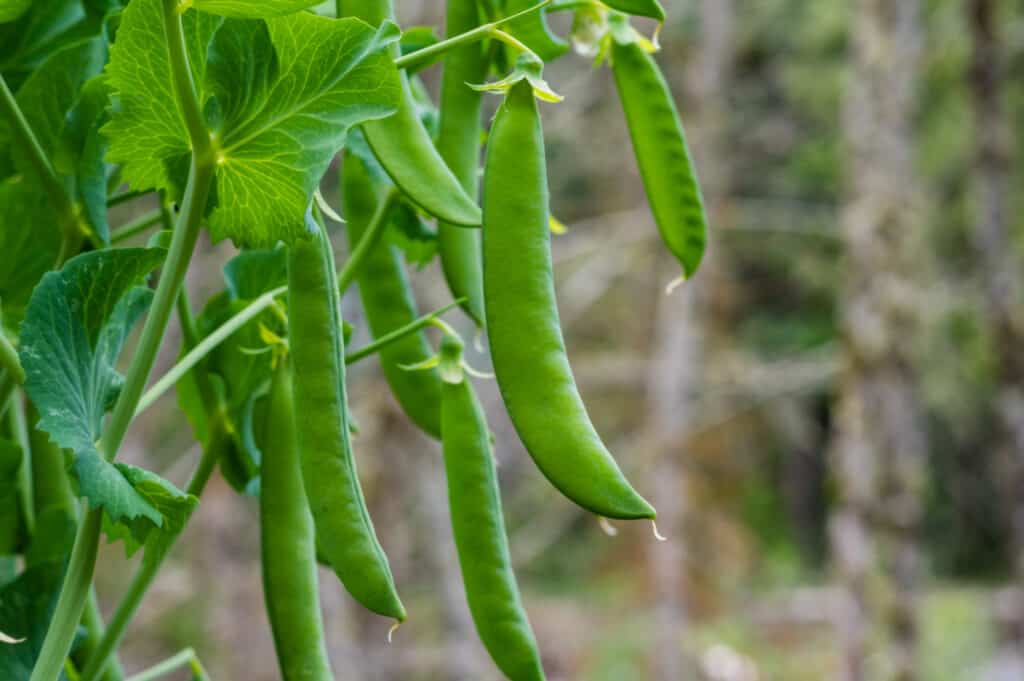
Homegrown peas are nothing like what you’d find in the store. I truly believe peas in your garden are more delicious than anything you could ever buy. Crisp, sweet, and so delicious, they are my all-time gardening favorites.
Best of all, they’re one of the easiest plants to grow no matter where you live, making them a great addition to any backyard garden.
Please can be planted early, as soon as the ground can be worked with no worries of a late snowfall. If you live in a mild area, you can sew peas in the fall.
Another bonus of growing peas is they can provide necessary nutrients to the rest of your garden. Whether you plant in the ground or in a raised bed, this amazing plant will thrive allowing you to enjoy the harvest throughout the summer.
What to Know Growing Peas
Peas are one of the easiest plants to grow, but their quality, once picked, is limited as they don’t stay fresh long after harvesting. Pick and eat right away or plan to use them in that day’s meal.
SLCG PRO TIP: If you plan to preserve your peas do not pick them until the very last minute. This will ensure your peas are preserved at the peak of freshness, giving you the very best taste later on.
St. Patrick’s Day is traditionally the day to plant peas in our area. You’ll want to plant them early enough to give them time to mature while the weather is still cool.
The best planting months are February, March, and April. If you live in a warmer climate, though, you can also grow them as a fall crop by planting in late summer or early fall, at least 6-8 weeks before the first expected frost.
Varieties of Peas
There are three varieties of peas that are best suited for a backyard garden.
Sweet Peas—These are also known as English peas or garden peas. Their pods are inedible, so the peas must be removed before eating.
Snow Peas – These produce an edible pod that is flat and stringless. Both the pods and the peas inside can be enjoyed together, and they can be made into a great snack while out working in your garden.
Snap Peas – Similar to snow peas, their pods are edible, but they are thick and contain larger full-size peas. These are my favorites and are lovely to snack on in the garden or take inside as a cool afternoon treat.
How to Grow Peas for Beginners
Peas are fairly easy to grow making them a perfect choice for beginner gardeners. When you plant at the right time, and following planting tips in this article, you’re almost ensured success.
Seeds or Plants
While you can plant seedlings that you start indoors, it’s not recommended. Seedlings don’t transition well in replanting as the action of removing it and planting in the soil disturbs their root system which will later dimmish their yield. For that reason, peas grow best when seeds are planted directly in the garden.
Temperature
Peas thrive in cooler weather and even the young plants can even tolerate a light frost. Soil temperature can play a big part in how fast the seeds germinate though. Seeds planted in soil that’s 40° can take more than a month to sprout while seeds planted in soil that’s 60° will sprout in about a week.
Sun
Peas need sunlight to grow, but not as much as many other plants in your garden. They actually only need about 5-6 hours of sunlight a day making them a perfect plant to place in a shadier area. As the temperatures rise and they get more sun, they can begin to fade out. Cooler spots with a little shade are the perfect area of your garden for growing a patch of peas. If you can, it is best to keep them cool and still provide sunlight for a nice long growing season.

Soil
When it comes to planting peas, you’ll need to give your soil some extra attention. Peas prefer soil that fertile, a little sandy, and well-draining. You’ll want to work in plenty of compost to provide extra nutrients to your plants.
READ: HOW TO COMPOST IN YOUR OWN BACKYARD
Soil with a pH of 6.0-7.5 is best for growing peas. If the soil is too acidic, add dolomite or agricultural lime.
Watering
It’s important to keep the soil moist; letting it dry out completely will drastically reduce your harvest. Be sure to water your pea plants deeply at least once a week, letting the water soak down into the soil. You can easily test for moisture by sticking your finger in the soil about an inch deep. If the soil is dry, you’ll need to water.
The most critical time for maintaining plenty of moisture is when the plants are blooming and producing pods. If the air temperatures are too warm during this time, you may need to water daily to the plants nourished.
Fertilizing
Pea plants are light feeders and really don’t require fertilizer. Too much nitrogen in the soil will make the foliage lush, but at the expense of pod production and the plants will be more susceptible to frost.
For best results, avoid fertilizing the soil.
How Many Seeds to Plant
For a full harvest with plenty to freeze or preserve for later, you’ll want to plan on 15-20 plants per person in your household. It’s always a good idea to plant additional seeds in case some don’t spout.
If you are a garden pea snacker, maybe a few more is a good idea. 😀
How to Grow Peas in a Garden
One of the most important things to know about planting and growing peas is that they are a climbing plant. That means they’ll need support, like a trellis or fence. A side effect of having a trellis/fence for your peas is it will cause a bit of shade for the rest of your garden. If shade is a no go for your other plants, you will want to locate your peas in the north side of your garden. This will help your pea patch to get the sunlight they need to grow while not creating shade for any of your other plants.
To speed up the germination process, soak your seeds in water overnight before planting them.
Sow your seeds thickly in wide rows. The seeds can be planted close together, but the rows should be at least 7” apart. When grown close together, the plants will help to shade out weeds and keep the soil cool which will not only produce a higher yield, it will also make the most efficient use of your space. You can simply sprinkle the seeds, allowing them to fall wherever they may in the row, even touching each other, no need to space.
When planting in the spring, an inch of soil cover is fine. If planting in the summer or the fall, plan for two inches of soil to cover your seeds.
Don’t thin the pea plants out when they germinate, just let them grow. No worries, they will still produce high-yielding plants.
All varieties of peas grow best with support. They’ll be more productive and less susceptible to disease and rot when they can grow up along a sturdy support system. You can plant them near a fence or install a trellis or a sheet of fence paneling.
I prefer to use cut portions of fence panels. It’s a great way to reuse items on the homestead without having to buy anything new.
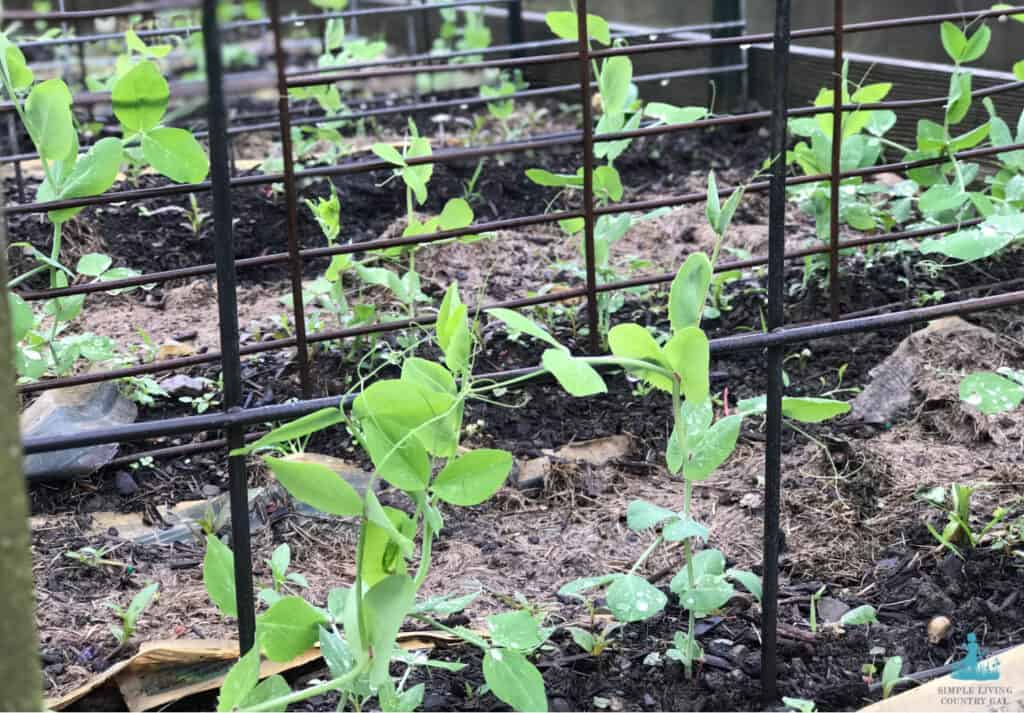
SLCG PRO TIP: No matter what support you decide on, be sure to put it into place before your seeds begin to germinate. The young plants will want it for support as soon as they sprout and will wind their way around anything they can reach. In this case, earlier is definitely better.
There are several factors that go into determining how long it will take your seeds to become fully producing plants, but if the soil is warm enough, and they’re getting plenty of water and sunlight, you can expect to be able to harvest your peas in about 2-3 months.
How to Care for Pea Plants
✔️ The size of your plants will depend on the variety of pea you plant. Bush peas will grow to about 18-30 inches tall while pole varieties will grow as much as 4-6 feet tall. Both varieties will need support as they grow.
✔️ Keep the soil moist, but not overwatered. Remember the finger test; feel the soil about an inch down, if it’s moist you don’t need to water. Watering once a week will be plenty unless the temperatures are high, then you may want to water a second time.
✔️ When first planted, because they’re only about an inch deep, some seeds may wash out of the soil. Simply poke them back in.
✔️ Pea roots are shallow and fragile. If you find weeds, pull them by hand, don’t use a hoe.
✔️ If the leaves start to turn yellow, it’s most likely because they’re getting too much sun. On the hottest days, add row covers to provide shade and check the soil for enough moisture.
✔️ A thin layer of mulch on top of the soil will help to keep it cool, retain moisture, and reduce weeds.
When to Harvest Pea Plants
Most pea varieties are ready to harvest in about 60-70 days.
- For snow peas, you will want to pick them when the pods begin to show immature seeds inside.
- Snap peas should be picked when the pods are plump with peas but still glossy on the outside.
- Shell peas should be picked before the pods become waxy.
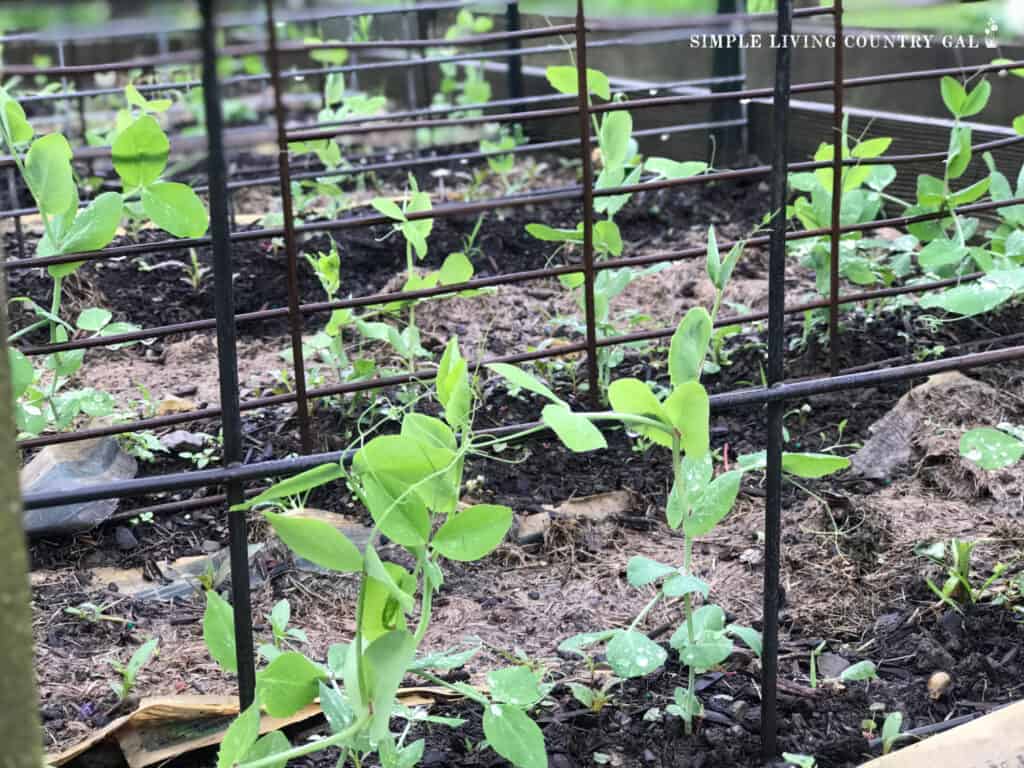
Peas will reach maturity quickly once they start to bloom; check them daily once you begin to see the flowers.
The best time of day for picking is in the morning after the dew has dried. They’ll be at their most crisp then. Pick the pods regularly to encourage the growth of new pods.
To protect the vine and the pod, use two hands when picking. Hold the vine with one hand and pick the pod off with the other.
Plan on enjoying your harvest within a day or prepare your peas for canning or freezing while they still have most of their flavor. They’ll lose their flavor quickly so you won’t want to store them.
Growing Tips for Peas
✔️ For the best pea harvest, rotating your garden crops will help keep the soil at its best. A good guideline is to not plant peas in the same place more than once every four years.
✔️ Pea roots will add nitrogen and replenish the soil, making it beneficial for other plants in your garden. You can follow by planting heavy feeders such as tomatoes or squash in an area where you previously grew peas.
✔️ To get your seeds germinating as quickly as possible, plant them in raised beds. The raised beds will warm up faster than ground soil.
✔️ Pods that have hardened and turned dull in color are over mature. Unfortunately, over mature plants usually stop producing and die out in the hot summer.
✔️ If you missed the peak period for your peas, you can still salvage them for use later. Pick them, dry them, and shell them for use in soups over the winter.
Things to Watch for When Growing Peas
#1. Deer and rabbits
Deer and rabbits can become a problem in your garden and they both love sweet peas. There are a few ways you can deter them. If you’re growing other vegetables in your garden, planting onions and garlic around the edges of your garden can help to keep them away.
You can also place pieces of a strong-smelling soap around the garden to keep them out or use wire mesh around your plants.
#2. Mexican Bean Beetles, and Wireworms
If the foliage is misshapen, yellowing, and has holes in it, you might have these pests in your garden. You can plant companion plants that repel them (basil, rosemary, or other strongly scented plants), remove them by hand or spray them off with water. For protection against wireworms, sow the seeds in warm soil for fast germination and provide good drainage.
#3. Diseases
Peas are also susceptible to some diseases, a variety of fungus, mold, and mildew. Some plants are resistant to these diseases. If you find signs of any disease, mold, or mildew, remove the affected plant immediately and destroy it.
Signs of mold may show up on the pea pods in the form of a white cottony substance or black spots. If you see this, remove the pods from the plant. The plant itself should still be healthy and can continue to produce.
Keeping the soil moist but not oversaturated and providing plenty of sunlight will help deter many of these pests and diseases.
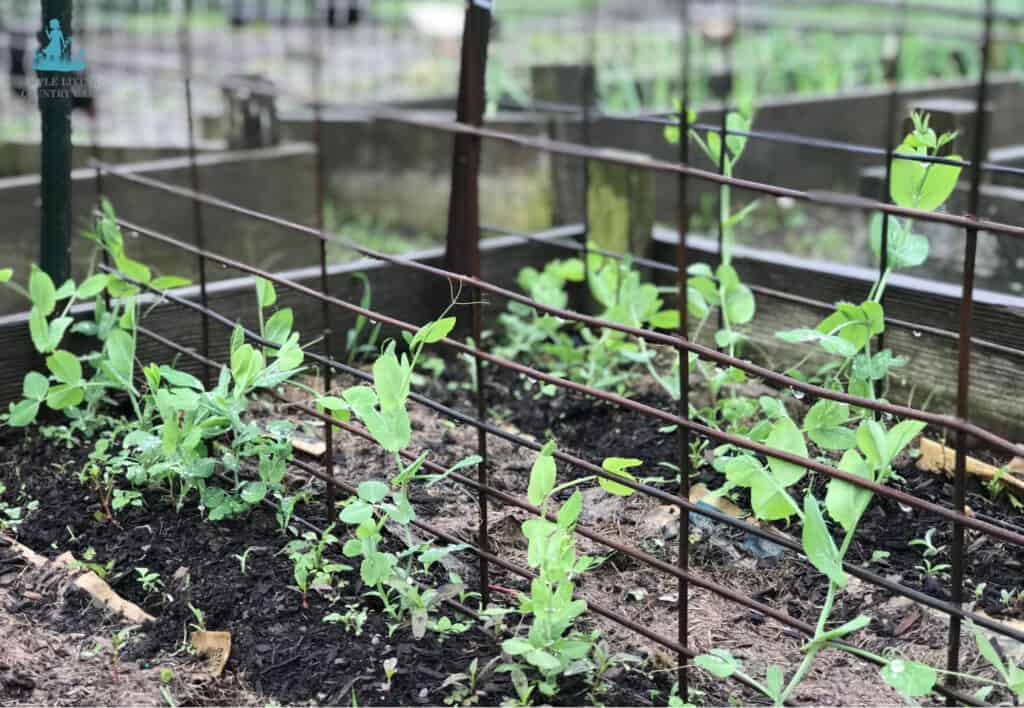
Storing Peas
Your harvest of peas can be stored in the refrigerator for up to 5 days by placing the peas in a paper bag and wrapping it in plastic.
You can also freeze them, which is super easy and a great way to get started with food preservation.
How to freeze peas
- Shell and wash your peas and put them into a bowl.
- Blanch by dropping them into the pot of rapidly boiling water.
- Let them cook for just 1 1/2 minutes. Do not overcook your peas or they will become mushy.
- Drain quickly with a colander.
- Immerse them in cold ice water until cool.
- Drain them and pack them into freezer containers or freezer bags.
- Be sure to date everything you preserve.
Peas are a healthy and delicious addition to your summer table and you can store them dried or frozen for use in soups and stews all winter long. They’re a high-yielding plant that can also provide nutrients to your other plants and they’re easy to grow making them the perfect plant for beginning gardeners.
Find a spot in your garden or place a raised bed in an area that gets good sunlight, add a trellis, and get planting! When it comes to growing peas, they’re almost foolproof.



how deep should the soil be for growing peas, I’m trying to grow them in a green house
If you are growing peas in a container, you will want at least 8″ or more to grow. Then you can plan the peas following the seed packet instructions which is around 1-1/2 inches deep.